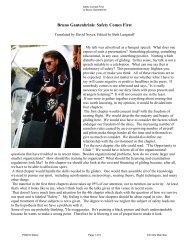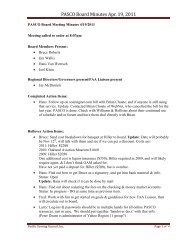2006 March (529kB) - Pacific Soaring Council
2006 March (529kB) - Pacific Soaring Council
2006 March (529kB) - Pacific Soaring Council
You also want an ePaper? Increase the reach of your titles
YUMPU automatically turns print PDFs into web optimized ePapers that Google loves.
handles down at the same time a few feet before<br />
landing, much like flaring an airplane. These “apples”<br />
are actually non-rigid airfoils. Your round “orange” is an<br />
umbrella, not a wing. If you try to flare a round<br />
parachute, you will, at best, increase your decent rate,<br />
and at worst, partially collapse the canopy. A partially<br />
collapsed canopy will reinflate in about 20 feet. This is<br />
not good if you are 18 feet above the ground! More on<br />
landings later.<br />
WHERE WILL YOU LAND?<br />
Most steerable, round parachutes are designed to have<br />
about a 5 mph forward speed. Air flowing up into the<br />
canopy is forced out the vents in the rear. Kind of like a<br />
jet engine but without all the noise. This dampens<br />
oscillations and makes the parachute steerable. The<br />
5mph forward speed created by the vents cannot be<br />
stopped. Pretend the gas peddle is stuck at 5mph. With<br />
this knowledge and the diagram in Figure 7 you can get<br />
a rough idea of where you’re drifting. If there is no wind,<br />
then you’ll be going 5mph in any direction you are<br />
facing. If you don’t like what’s in front of you, turn and<br />
head in a new direction at 5mph.<br />
downwind of the obstacle, turn back into the wind. You<br />
won’t make it back to that obstacle unless the wind dies<br />
down and you have enough altitude.<br />
TIP: Steer away from roads. Besides the obvious<br />
danger of getting hit by a car (a real bummer after just<br />
surviving a heroic bailout!), power lines usually run<br />
alongside roads and can be hard to see until it’s too late.<br />
In our final scenario the wind is blowing at 10 mph (or<br />
any speed faster than the 5 mph forward speed of your<br />
parachute). Facing into the wind will have you drifting<br />
backwards, but it’s better to land going backwards at 5<br />
mph instead of facing forward going 15mph. Just<br />
remember to glance over your shoulder on the way<br />
down to see what obstacles you might be heading<br />
towards.<br />
ON THE GLIDESLOPE<br />
For a parachute to be certified, it must have a decent<br />
rate of no more than 24 feet per second. Decent rate is<br />
affected by your weight and also the model of parachute<br />
you choose, but for the average person, 16 feet per<br />
second is a good number to work with. Couple that with<br />
the 5 mph forward speed and you’re looking at a glide<br />
slope of about 45 – 60 degrees. Of course, this will vary<br />
with the wind and other factors, but we’re not concerned<br />
about doing trigonometry during a bailout. We’re dealing<br />
with a rule of thumb that will help save your life. If you<br />
look down (or behind you, depending on which way you<br />
are drifting) about 45 – 60 degrees, that will give you a<br />
good approximation of where your touchdown area is<br />
going to be. If you don’t like what’s there, turn and go<br />
somewhere else (if altitude permits). Just remember<br />
miss obstacles first, and then face into the wind.<br />
K.I.S.S. THE GROUND<br />
Hopefully, you won’t be bailing out on a regular basis, so<br />
I use the KISS method (Keep It Simple Stupid) when<br />
teaching landings. If you’ve had any military training,<br />
you might be familiar with the “parachute landing fall” or<br />
PLF. During a bailout, you’re not trying to be a<br />
paratrooper so don’t worry about it. Landing under a<br />
modern emergency parachute is about the same as<br />
jumping off of something 3 – 5 feet high. You could do<br />
that without any special training, right? Landing your<br />
parachute is no different.<br />
In the unlikely event that the wind is blowing at exactly<br />
5mph, you’ll be coming straight down if you face into the<br />
wind. Look below you and decide if this is where you<br />
want to land. If you see something that you would not<br />
like to land on (like those ever-present power lines) and<br />
have plenty of altitude, just turn your parachute180<br />
degrees and head downwind at 10mph. Once you are<br />
21<br />
It is usually more comfortable to hang in a parachute<br />
harness with your legs slightly out in front of you. Just<br />
make sure to get them under you before you land so you<br />
don’t hit your tailbone. Keep your feet together to help<br />
brace your ankles, and don’t lock your knees. Land on<br />
the balls of your feet and try to take up most of the<br />
landing shock using your leg muscles like the springs of<br />
shock absorbers, bending them enough to cushion and<br />
slow your landing. You might get pulled over by the<br />
parachute or you might fall over if you’re drifting across<br />
the ground, but if you absorb most of the landing with<br />
your feet and legs, you are less likely to receive severe<br />
upper body injuries, especially to your head. Practice















